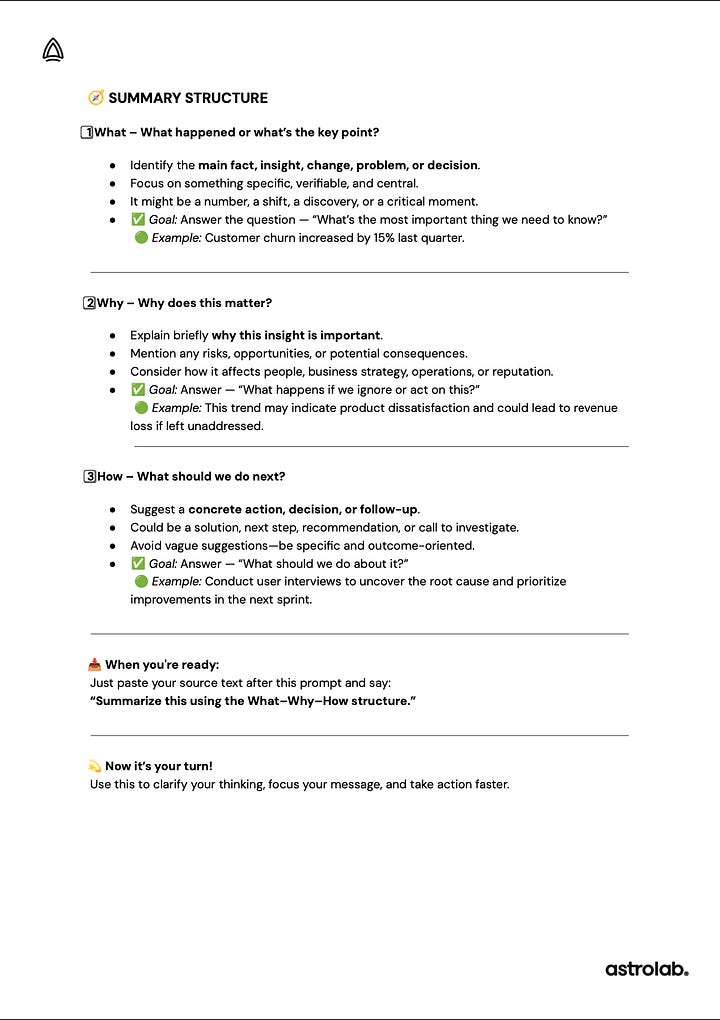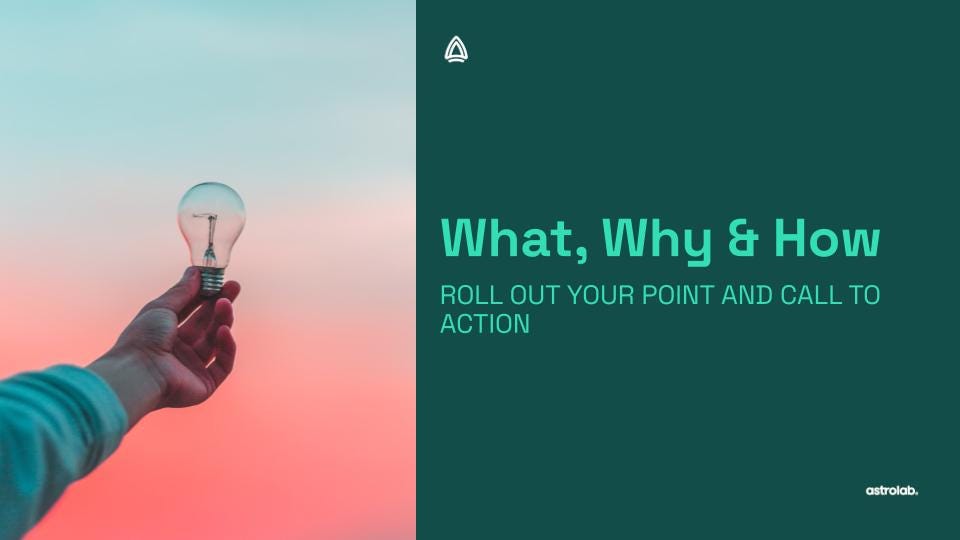How to pitch an idea to your boss
A tool for action
Today: Andrés talks about What, Why, How, a communication framework that is very effective when presenting recommendations or plans to a busy stakeholder. Also, an interview with Dylan, who leaves Astrolab to start a learning consultancy.
Humans learn by experience, but not all experiences have the same impact on our learning outcomes. Experiences that are recurring tend to stick with us, and become lasting insights about the world.
For almost fourteen years, I’ve been helping knowledge workers understand how to get better at winning others over when communicating in conversations, presentations, meetings, one-on-ones, and even written messages.
Here are three insights that synthesize my learning journey at Astrolab:
Ideas are not enough to persuade people
Stories are a great way to build connection and inspire action
It's easy to underestimate the impact some meetings with senior stakeholders—leaders, clients, investors, future bosses—have on your career
In this INFLUX 🪐 edition, I’ll share a framework that will help you prepare for those meetings that can make, break—or brake—your career.
There’s a Mexican legacy company that has an annual revenue of $15B where, at least in one of their biggest business units, you can’t get to a leadership position if a certain person in the company doesn’t vouch for you after a one-on-one interview.
Now, there are equivalents in your organization: it is really hard to get a senior or leadership role if you’re not able to wow people during presentations. It seems unfair, considering that preparing and delivering these types of presentations account for a small portion of your time compared to the rest of your activities, but it is a practice I see everywhere.
The framework, called What, Why, How, and it’s the culmination of a decade of research, testing, and implementation in real projects.
The framework
Astrolab is a professional development training firm. Until recently, we only had one learning experience, INSPIRA Storytelling. Let’s Be Clear is our second workshop.
We spend the rest of our time helping leaders craft and share narratives around decisions or changes.
In this second line of work we’ve spent thousands of hours trying to find the perfect narrative structure, one that is general enough but with room for flexibility, and one that makes it easy for teams to align around the most important pieces of information.
After reviewing and working actively with many different narrative structures, including Simon Sinek’s Golden Circle, Barbara Minto Minto’s Pyramid, Anecdote’s Clarity Story, Terry Borton’s What, So What, Now What), we’re convinced that a structure that
Starts with the suggested action,
Moves into the reasons behind the action, and
Finally get into logistics,
is the best way to go. It is intuitive, brain-friendly, and has a good ratio of simplicity-complexity that allows it to grow.
What, Why, How (WWH) is our best answer. I’ll briefly explain what goes into each of these three elements:
What are you proposing? (Start with the recommendation, not the background)
Why does it matter now? (The rationale, problem, urgency, benefit, vision, purpose)
How will it work? (The action steps, timeline, or key considerations)
WWH makes it easy for you to share in fifteen seconds, minutes, or months what is the course of action, why it matters, and what are the details and logistics.
The examples
Here’s a brief example:
(What) I recommend we move ahead with Vendor A for our summer campaign.
(Why) They’ve outperformed others in both cost and speed, and we need to launch by June 1st.
(How) Here’s how we’d do it: finalize the contract by next week, kick off the creative process by April 10, and begin testing by mid-May.
Here’s another example:
(What) We’re making changes to how we work to boost productivity and deliver better results for our clients.
(Why) Over the past six months, productivity has dropped 20%, causing delays and client dissatisfaction. Teams have flagged unclear priorities, too many meetings, and outdated tools as key blockers. If we don’t act, we risk burnout and losing momentum.
(How) We’ll start using clear frameworks like OKRs or Agile sprints, reduce unnecessary meetings, centralize communication, and upgrade our tools with smarter automation to streamline workflows.
WWH has many uses. Here are some ideas:
Writing an executive summary slide
Kicking off a project
Delegating a task
Presenting a roadmap
Introducing a new internal tool
Summarizing a new project plan to other functional areas
Final note: this framework does not pretend to be exhaustive. On the contrary, it is a structure that can and will adapt as time goes on.
It is not a script but rather a set of principles, if you want to.
The prompt
If you want to try this tool, use the following prompt in your favorite predictive AI tool, courtesy of Emilio from Astrolab.


That’s all for today!
– Andrés



